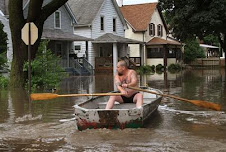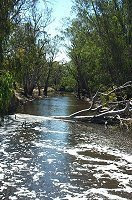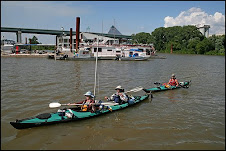What kind of boats will you be traveling in?
We will be paddling Feathercraft folding kayaks. Patrick will be paddling a K1 Expedition and Sarah and I will paddle a tandem K2 Expedition. The boats consist of a waterproof skin that is fit tightly over an aluminum frame. Feathercraft boats are top of the line expedition touring kayaks that are designed to be paddled even in rough open ocean conditions. Perhaps the most amazing thing about Feathercraft kayaks is that they can be disassembled and carried in a large bag. Click the link on the right to learn more about Feathercraft kayaks.
Where will you sleep?
Each night we will camp out on sandbars, islands, and in the bottomland forests that line the river. We don’t have any of our campsites planned out. We will look at the navigational charts each day and try to anticipate good campsites.
How will you fit all of your food in the kayaks?
The Feathercraft K1 and K2 expedition kayaks can carry fairly large payloads inside the boat. The K2 can hold around 700 lbs including paddlers and the K1 can hold about 385 lbs. We will be carrying a lot of food and equipment but should come nowhere close to the weight limits on either boat. We will need to restock drinking water roughly every 3-5 days. This should give us opportunities to supplement our food supplies with fresh meat and produce on occasion.
What kind of scientific equipment will you be using?
To measure nutrient pollution and dissolved oxygen in water samples we will be using a Hach DR850 colorimeter. A colorimeter is a piece of equipment that measures the absorbance of light as it passes through a solution. Reagents will be added to each sample to test for nitrates, phosphates and dissolved oxygen. In the presence of these substances the samples will change color and less light will pass through them. The colorimeter will measure how much light passes through the sample and will give a reading for the pollutant being tested in milligrams per liter (mg/L).
The colorimeter basically looks like an oversized calculator with a well towards the top. A glass container, called a cuvette, holds the water sample and gets placed in the well for testing. A cover is then placed over the sample during testing to keep out outside light as the colorimeter passes light through the sample.
For our study of large woody debris, or snags, we will simply be counting and marking the locations of snags in selected sections of river. We will be paddling close to the shore during these counts. The equipment we will be using for the counts will be our eyes, a pencil and notebook, and a handheld water proof GPS unit.
Got any more questions for the Soggy Science Team?
Please post them and we’ll respond.
2008/06/06
Subscribe to:
Post Comments (Atom)















1 comment:
Sounds like a really cool and interesting expedition =]
and sounds like itll be a great
expierence as well.
good luck
Post a Comment